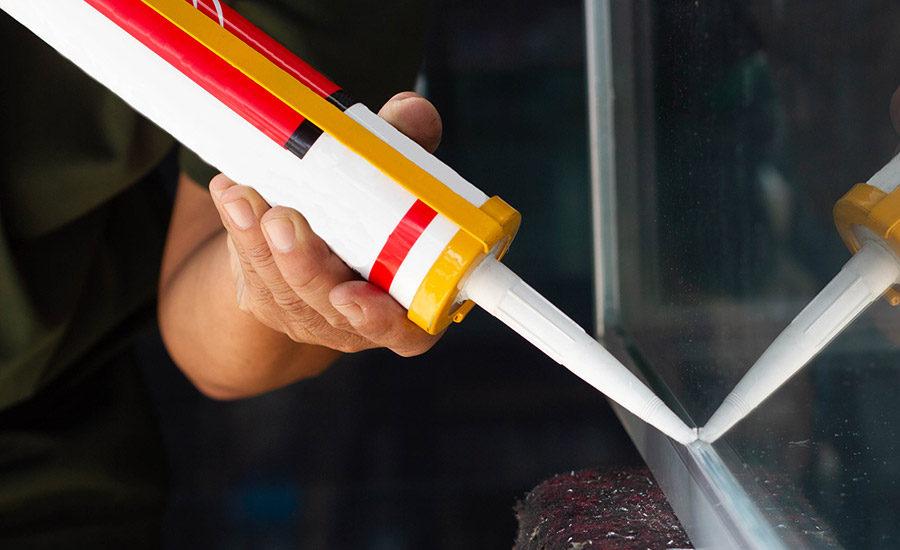- Specification—a set of requirements for a product or system
- Test Method—a specific procedure that produces a result
- Practice—a set of specific instructions for doing something but does not produce a result
- Guide—a compilation of useful information or options
Because standards establish performance criteria, consistent methods and acceptable practices, they are the most recognized way of implementing measures to address a need or problem. For example, the advent of curtain-wall construction required the use of high-performance elastomeric sealants. In 1967, Federal Specification TT-S-230a was adopted. This standard established minimum performance requirements and test methods for sealants used in commercial construction.
Standards have come mainly from government agencies and industry associations. The federal government was once very active in developing standards through the General Services Administration, and a number of federal specifications are still referenced today. However, the government turned such development activity over to the private sector represented by industry associations.
There are numerous associations that issue one or a few sealant standards to take care of their specific needs. For example, the EIFS Industry Members Association (EIMA) has a guide for use of sealants with exterior insulation and finish systems.
However, the most active associations developing industry-wide building-sealant standards are the American Society for Testing and Materials (ASTM) and the American Architectural Manufacturers Association (AAMA). Standards published by these associations are widely accepted because their large memberships are directly involved with industry needs and have the expertise to develop reliable standards.
Within ASTM, there are two committees significantly involved with sealants: Committee C24 on Building Seals and Sealants, and Committee E06 on Performance of Buildings. C24 has jurisdiction over standards specifically covering sealants. Familiar examples are specifications C 920 on Elastomeric Joint Sealants and C 834 on Latex Sealants.
Committee E06 is responsible for the performance aspects of buildings and their components such as windows, walls, roofs, etc. E06 standards, such as Specification E 1514 on Structural Standing Seam Steel Roof Systems, can contain sections devoted to sealant testing and performance requirements. In others, like Test Method E 773 on Accelerated Weathering of Sealed Insulated Glass Units, sealants are not addressed per se but are tested as part of a building component. Other ASTM committees also develop standards that are pertinent to sealants (i.e., D 11 on Rubber, D 08 on Roofing and Waterproofing and G 03 on Weathering).
AAMA serves the architectural-manufacturing industry and develops standards on products such as windows, doors, curtain walls, storefronts, coatings and sealants. AAMA’s Adhesive and Sealant Task Group is responsible for developing and maintaining AAMA’s sealant standards. Other AAMA task groups develop standards that contain sealant-related information such as AAMA’s Guide for Structural Sealant Glazing Systems.
Both ASTM and AAMA use a consensus method for standard development. To ensure technical accuracy, proposed standards and revisions go through a rigorous balloting process during which all comments are given due process. Comments or proposals from members and non-members alike can be made at any time and receive careful consideration.
Standards for sealants used in building construction have come a long way since the days when government specifications were all that existed. Most advancement can be attributed to the work done by ASTM and AAMA. Both are very active in developing new standards and refining existing ones.
The following is an overview of major developments and revisions published in recent years, current activities, and trends. The information is arranged according to subject (sealant type, performance property or use). Relevant standards and the association having jurisdiction over them are discussed.
Sealant Type
Elastomeric Sealants/ Specification C 920
The most recognized specification covering elastomeric sealants in the U.S. is ASTM C 920 under the jurisdiction of Committee C24’s Subcommittee C24.20 on General Sealant Standards. In 1998, C 920 became a “generic” specification (i.e., no longer limited to chemically curing sealants). It is now open to any elastomeric sealant regardless of chemistry. The test method specified for the weight-loss requirement was changed to C 1246 that determines the effects of long-term exposure to high temperature. Unlike the previous test method, it does not include loss of carriers such as water or solvent that occurs during cure.
Another major change to C 920 was the addition of a new classification, Use I, in 1998. Use I covers sealants designed for use in joints that are submerged continuously in a liquid. The applicable test method is C 1247.
Currently C 920 has two joint-movement classes, Class 121¼2 and Class 25. These correspond to movement capabilities of 25% (± 12 1/2%) and 50% (± 25%) total movement. Since there are commercially available sealants capable of higher movement, new classes are needed to cover them. The addition of two classes, Class 50 and Class 100/50, with 100% (± 50%) and 150% (+100/-50%) total movement has just been approved, and the revision will be published in 2001.
Other proposed revisions to C 920 are in progress. Task groups are currently investigating new test methods for accelerated weathering, adhesion and color change. New requirements for sealants used in traffic areas (Use T) are also being considered.
Latex Sealants Specification C 834
Latex or emulsion sealants that do not meet C 920 are covered by C 834 Specification for Latex Sealants under the jurisdiction of Committee C24’s Subcommittee C24.16 on Emulsion Sealants. In 2000, C 834 was upgraded to include clear latex sealants. Previously, only opaque sealants filled with extender pigments such as calcium carbonate could meet the 30% maximum requirement for volume shrinkage. Two classification types have been incorporated, Type P for pigmented and Type C for clear or translucent sealants. Type P sealants still have to display 30% or less shrinkage while Type C sealants are allowed up to 50% shrinkage. These two types are further classified into three grades according to their ability to pass a low-temperature bend using Test Method C 734: Grade -18º is flexible at -18ºC (0ºF); Grade 0º is flexible at 0ºC (32ºF); Grade NF is not flexible at low temperature.
Test Method C 732 on artificial weathering is being revised to incorporate the different kinds of weathering machines (weatherometers) now in use and to increase the exposure time from 500 hours to 1,000 hours. A draft method is now in the ballot process.
Other standards for latex sealants being developed by C24.16 are:
- Extensive testing on mildew resistance has been done. Work was based on ASTM Test Method G 21 that uses a petri dish procedure. A method tailored to sealants is being drafted.
- A guide that will alert the user to the many variables affecting paintability has been drafted and is in the ballot process.
- A new test method for low service temperature is being developed to replace the low-temperature bend test C 734. This activity is in the ruggedness testing stage, and a method has not yet been drafted.
Aerosol Foam Sealants
For those not familiar with this terminology, these products foam dramatically when dispensed from a pressurized can. They are used to fill and insulate large cavities around a variety of penetrations, such as pipe and electrical pass-throughs and rough openings around windows or doors.
Until recently, there was no call for development of standards even though these products have been around for many years. However, the development of standards for window and door installation (which will be discussed later) prompted a need for standards to measure their characteristics and specify their performance requirements.
Both ASTM C24 and the AAMA Sealants Task Group are in the process of developing such standards. C24 created a new subcommittee, C24.61 on Aerosol Foam Sealants, as their responsible group. Within this subcommittee, there are task groups working on test methods for volumetric yield and post-dispensing expansion and specifications for polyurethane and latex types. AAMA has also created a sub-task group to work on performance requirements relevant to window and door installation. One of the concerns in this area is that a frame may be distorted by the generation of pressure as the foam expands.
Preformed (Pre-Cured) Joint Sealants
This type of sealant is actually a system comprised of a rubber ribbon and an adhesive. The adhesive is used to adhere the ribbon to the two surfaces adjacent to the joint, thus creating a “bridge” or “band aid” sealant joint. Work is being done in ASTM C24’s Subcommittee C24.32. The first two industry standards, a test method for joint movement durability and a specification, will be published in 2001. Work is also in progress on a test method for evaluating adhesion in the field.
General (Generic) Sealant Standards
When standards apply to a variety of sealant types, they are known as general or generic standards. For example, ASTM C 1375 Guide for Substrates Used in Testing Building Seals and Sealants, approved in 1997, describes standard materials and their surface preparation when used for sealant testing. Any sealant test method that uses glass, anodized aluminum or mortar substrates can reference C 1375.
At one time, each type of sealant (i.e., chemically curing, latex, and solvent-release) had separate ASTM guides on how to use them. In 1991, the guides were combined into one, C 1193 Standard Guide for Use of Joint Sealants. In 2000, the guide was significantly revised to include the latest techniques and information. This is one of the most important sealant standards because it covers every aspect of sealant use that should be considered by designers and applicators.
Another useful general sealant guide is C 1299 Guide for Use in Selection of Liquid-Applied Sealants. Although not new (first published in 1995), it is worth mentioning. It gives a comparison of properties and applicable ASTM standards for all “liquid” sealants by chemical type, i.e., polyurethane, butyl, acrylic latex, etc.
Volatile Organic Compound (VOC) emission from caulks and sealants is the subject of a standard practice being developed by ASTM Committee D22 on Sampling and Analysis of Atmospheres and is the responsibility of Subcommittee D22.05 on Indoor Air. The practice is a detailed procedure for determining indoor VOC emission using small environmental chambers. This is not a method that most sealant manufacturers could perform since analytical procedures include headspace gas chromatography (GC) and combined GC and mass spectroscopy. The standard is currently in the ballot process at the subcommittee level.
Sealant Use
Exterior Insulation and Finish Systems (EIFS)
EIFS, sometimes referred to as synthetic stucco, is a popular form of exterior wall cladding. It has unique requirements for sealant joints. In the early 1990s, extensive problems with water infiltration received national attention and resulted in a plea for standards. The problems were attributed to the lack of sealant joints or improper sealant selection and application.
ASTM Committees C24 and E06 began to develop the standards. C24.20 has published two standards: Test Method C 1382 (1998) that measures the tensile-adhesion properties of sealants in test specimens that simulate an EIFS joint; and Guide C 1481 (2000) on the use of sealants with EIFS. E06.58 is developing or has standards that do not address sealants per se, but some include references to sealant joints and related information. In addition to these activities, EIMA (mentioned earlier) has a guide that shows the variety of sealant-joint conditions found in EIFS.

Structural Sealant Glazing
In this type of commercial glazing, a structural sealant holds a light or panel to a framework without fasteners or other attachment. Sealant performance and proper sealant joints are critical. ASTM C24 and AAMA have published standards. C24.35 has been prolific with 10 standards. The most recent are:
- C 1392 Guide for Evaluating Failure of Structural Sealant Glazing
- C 1394 Guide for In Situ Structural Silicone Glazing Evaluation
- C 1401 Guide for Structural Glazing
- C 1487 Guide for Remedying Structural Silicone Glazing
In 2000, AAMA completed a major update of its Structural Silicone Sealant Glazing Guide that is in the process of being published.
Window and Door Installation
Litigation over wall and interior damage caused by water infiltration around windows and doors reached such proportions in the early 1990s that industrywide action was needed. ASTM E06 and AAMA have responded with standards for installation of residential windows and doors.
Subcommittee E06.51 on Performance of Windows, Curtain Walls and Doors has developed Practice E 2112 for Installation of Exterior Windows, Doors and Skylights. It will be published in mid-2001.
In November 2000, AAMA implemented its InstallationMasters Program that includes installer training and a procedural manual. Both the ASTM practice and the AAMA manual are very detailed, covering every aspect and procedure for proper installation. Both include extensive information on sealant selection and application and where sealants are to be used. AAMA’s Adhesive and Sealant Task Group is developing a specification and test methods to specifically cover sealants used for installation.
Sealant Properties
Weathering
Weathering, or how well a sealant holds up to exterior exposure, is one of the most popular subjects in standards development. Everyone wants to know how long a sealant will last; only they don’t want to wait several years to find out. Therefore, much research has been and is being done to correlate accelerated weathering to actual exterior exposure. The objective is to create test methods that will give reliable results in a reasonable time.
Current ASTM standards require 250 to 1,000 hours of accelerated exposure, which by most studies is too short to predict long-term performance. Also, there are different types of weatherometers in use. Being able to correlate results from one to the other is a standardization challenge.
Most ASTM C24 subcommittees are working on upgrading their weathering standards to increase exposure time and include the latest machines. Work is also being done to “harmonize” existing and proposed standards. The first “generic” standard, C 1442 Practice for Conducting Tests on Sealants Using Artificial Weathering Apparatus, was published in 1999.
Other activities are in progress. A test method that combines exposure and joint movement of elastomeric sealants is in the ballot process. Work has just started on a practice for conducting actual outdoor (test fence) exposure.
Joint Movement
How much movement will occur in a joint? How wide should the joint be and how much movement capability should the sealant have in order to withstand the movement? Answers to these questions can now be determined with ASTM C 1472 Guide for Calculating Movement and Other Effects When Establishing Sealant Joint Width. This guide was published in 2000. It is an in-depth treatment of the factors that should be accounted for when establishing sealant-joint size.
Summary
There is much activity in the development of standards for, or related to, sealants for building construction. ASTM and AAMA are the associations most prolific with these standards. It is important that companies involved in the sealant industry stay abreast of their activities in order to meet and claim the latest specification requirements and to improve or develop products that will comply with future requirements. To provide an overview and stimulate interest, this article has touched on several of their recent developments and some of the work in progress.
For more information, email edc@schneemorehead.com or visit www.schneemorehead.com.
This article is based on a presentation made at the Spring 2001 Adhesive and Sealant Council Convention in Orlando, Fla. For information regarding the ASC, visit www.ascouncil.org.


